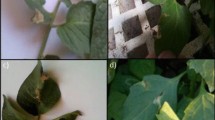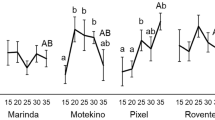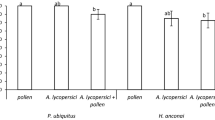Abstract
Tomato varieties used at present for commercial production in Dutch glasshouses have a high density of glandular trichomes on the stem, but a very low density on the leaves. The two-spotted spider mite,Tetranychus urticae Koch, and the predatory mite,Phytoseiulus persimilis Athias-Henriot, usually disperse from leaf to leaf via the stem, thereby incurring high risks of entrapment (and death) in the exudate of the glandular trichomes. These risks have been quantified on the tomato cv. ‘Turbo’ and an accession ofLycopersicon peruvianum almost free of glandular trichomes. The possible consequences for biological control are discussed and new perspectives for predator release strategies and for plant breeding are considered.
Similar content being viewed by others
References
Aina, O.J., Rodriguez, J.G. and Knavel, D.E., 1972. Characterizing resistance toTetranychus urticae in tomato. J. Econ. Entomol., 65: 641–643.
Cantelo, W.W., Boswell, A.L. and Argauer, R.J., 1974.Tetranychus mite repellent in tomato. Environ. Entomol., 3: 128–130.
Carter, C. and Snyder, J.C., 1985. Mite responses in relation to trichomes ofLycopersicon esculentum x L. hirsutum F2 hybrids. Euphytica, 34: 177–185.
Gentile, A.G., Webb, R.E. and Stoner, A.K., 1969.Lycopersicon andSolanum spp. resistant to the Carmine and the two-spotted spider-mite. J. Econ. Entomol., 62: 834–836.
Gibson, R.W., 1976. Trapping of the spider miteTetranychus urticae by glandular hairs on the wild potatoSolanum berthaultii. Potato Res., 19: 179–182.
Good, D.E. and Snyder, J.C., 1985. Environmental variation of trichomes and leaf oils onLycopersicon leaflets. Hortic. Sci., 20: 590.
Hussey, N.W. and Scopes, N.E.A., 1985. Greenhouse vegetables (Britain). In: W. Helle and M.W. Sabelis (Editors), Spider Mites (World Crop Pests, Vol. 1B). Elsevier, Amsterdam, pp. 285–296.
Kennedy, G.G., Yamamoto, R.T. and Dimock, M.B., 1981. Effect of day length and light intensity on 2-tridecanone levels and resistance inLycopersicon hirsutum f. glabratum toManduca sexta. J. Chem. Ecol., 7: 707–716.
Luckwill, L.C., 1943. The genusLycopersicon. Aberdeen Univ. Stud. no. 120, 44 pp.
Rasmy, A.H., 1985. The biology of the two-spotted spider miteTetranuchys urticae as affected by resistant solanaceous plants. Agric. Ecosyst. Environ., 13: 325–328.
Ravensberg, W.J., van Lenteren, J.C. and Woets, J. 1983. Developments in application of biological control in greenhouse vegetables in the Netherlands since 1979. IOBC bulletin WPRS 1983/VI/3: 36–48.
Snyder, J.C. and Carter, C.D., 1984. Leaf trichomes and resistance ofLycopersicon hirsutum andL. esculentum to spider mites. J. Am. Soc. Hortic. Sci., 109: 837–843.
Snyder, J.C. and Carter, C.D., 1985. Trichomes on leaves ofLycopersicon hirsutum, L. esculentum and their hybrids. Euphytica, 34: 53–64.
Stoner, A.K., Frank, J.A. and Gentile, A.G., 1968. The relationship of glandular hairs on tomatoes to spider mite resistance. J. Am. Soc. Hortic. Sci., 93: 532–538.
Stoner, A.K. and Stringfellow, T., 1966. Resistance of tomato varieties to spider mites. J. Am. Soc. Hortic. Sci., 90: 324–329.
Williams, W.G., Kennedy, G.G., Yamamoto, R.T., Thacker, J.D. and Bordner, J., 1980. 2-Tridecanone: A naturally occurring insecticide from the wild tomatoLycopersicon hirsutum f. glabratum. Science, 207: 888–889.
Author information
Authors and Affiliations
Rights and permissions
About this article
Cite this article
Van Haren, R.J.F., Steenhuis, M.M., Sabelis, M.W. et al. Tomato stem trichomes and dispersal success ofPhytoseiulus persimilis relative to its preyTetranychus urticae . Exp Appl Acarol 3, 115–121 (1987). https://doi.org/10.1007/BF01270473
Accepted:
Issue Date:
DOI: https://doi.org/10.1007/BF01270473




